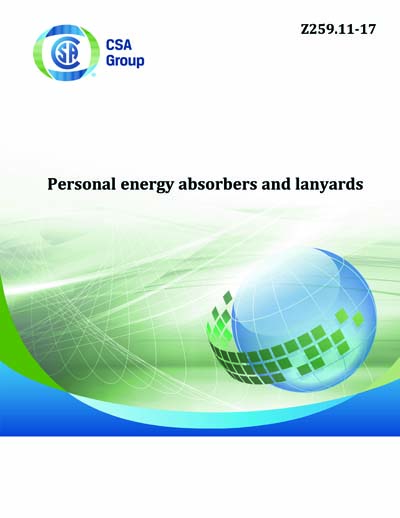Historical
CSA Z259.11-2017
Z259.11-17 - Personal energy absorbers and lanyards
Preface
This is the third edition of CSA Z259.11, Personal energy absorbers and lanyards. It supersedes the previous editions, published in 2005 under the title, Energy absorbers and lanyards, and in 1992 under the title, Shock Absorbers for Personal Fall Arrest Systems. The purpose of this Standard is to specify requirements for the performance, design, testing, labeling, and marking of personal energy absorbers and lanyards. The major differences from the previous edition include a) updating of the reference publications; b) updating of the definitions; c) addition of Class Y lanyard; d) removal of the energy absorber classifications of E4 and E6; e) the addition of the concepts of a minimum performance factor, a maximum force of deceleration, and an average deceleration factor for energy absorbers; f) revisions to dynamic drop tests; g) change in the test mass for the energy absorber and lanyard drop test; h) addition of a static resistance test for the Class Y lanyard; and i) addition of new labelling requirements. CSA Group gratefully acknowledges the financial and in-kind support from the Canadian government departments responsible for occupational health and safety for the development of this edition.Scope
1.1 General This Standard specifies requirements for the performance, design, testing, marking, and instructions of personal energy absorbers and lanyards, including lineman%u2019s pole straps and integrally connected lanyards and energy absorbers. 1.2 Applications Energy absorbers and lanyards are used as parts of complete fall arrest, travel restraint, fall restrict, or work positioning systems, as applicable. The scope of this Standard does not include information regarding the proper selection of components in order to assure the intended performance of these systems. The dynamic drop tests described in this Standard are intended to demonstrate that products covered by this Standard have the necessary strength and durability to provide an acceptable level of service. These tests do not imply that all products covered by this Standard can be used for fall arrest. The distinction between fall arrest, travel restraint, and work positioning applications should be made by the worker and the appropriate equipment should be selected. 1.3 Exclusions This Standard is not intended for lanyards that are used exclusively as anchorage connectors or used for recreational activities such as climbing or mountaineering. 1.4 Tolerances Unless otherwise stated within this Standard, all units have an acceptable tolerance range of ± 2%. 1.5 Units of measure The values given in SI units are the units of record for the purposes of this Standard. The values given in parentheses are for information and comparison only. 1.6 Terminology In this Standard, shall is used to express a requirement, i.e., a provision that the user is obliged to satisfy in order to comply with the standard; should is used to express a recommendation or that which is advised but not required; and may is used to express an option or that which is permissible within the limits of the Standard. Notes accompanying clauses do not include requirements or alternative requirements; the purpose of a note accompanying a clause is to separate from the text explanatory or informative material. Notes to tables and figures are considered part of the table or figure and may be written as requirements. Annexes are designated normative (mandatory) or informative (non-mandatory) to define their application.CSA America, Inc. [csa]

